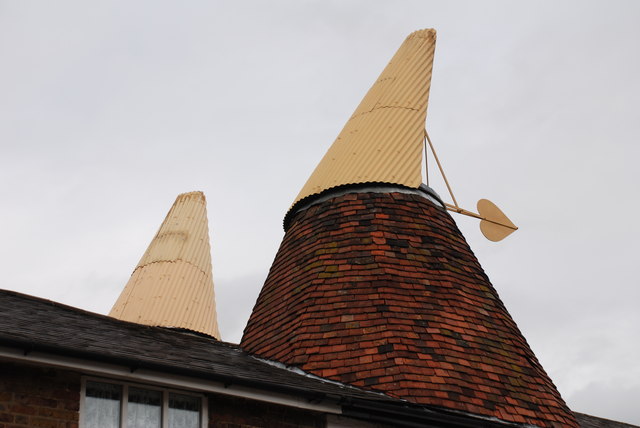|
Oast
An oast, oast house (or oasthouse) or hop kiln is a building designed for kilning (drying) hops as part of the brewing process. Oast houses can be found in most hop-growing (and former hop-growing) areas, and are often good examples of agricultural vernacular architecture. Many redundant oast houses have been converted into houses. The names "oast" and "oast house" are used interchangeably in Kent and Sussex, but in Surrey, Hampshire, Herefordshire and Worcestershire they are called "hop kilns". An oast house consists of a rectangular one- or two-storey building (the "stowage") and one or more kilns in which the hops were spread out to be dried by hot air rising from a wood or charcoal fire below. The drying floors were thin and perforated to permit the heat to pass through and escape through a cowl (oast), cowl in the roof which turned with the wind. The freshly picked hops from the fields were raked in to dry and then raked out to cool before being bagged up and sent to the bre ... [...More Info...] [...Related Items...] OR: [Wikipedia] [Google] [Baidu] |
Cowl (oast)
A cowl is a device used on a kiln to keep the weather out of and to induce a flow of air through the kiln. They are normally associated with oasts but can also be found on breweries (Letheringsett, Norfolk), maltings (Ware, Hertfordshire; Hadlow, Kent) and watermills (East Linton, East Lothian). Construction This section deals with the traditional cowls found on oasts, with particular reference to the South East. From the outside, a cowl appears to just sit on the roof of the kiln. High in the roof of the kiln is a beam spanning the centre, called the ''sprattle beam'', this carries a bearing which the gudgeon, pintle on the bottom of the ''centre post'' sits in. At the top of the kiln, the centre post passes through a two or three armed ''top stay iron''. At the top of the centre post is carried the ''back board'' which carries an elm ''curb ring'' at the bottom, and one or two curb rings higher up on all except the smallest of cowls. A ''tie beam'' could also be carried, either ... [...More Info...] [...Related Items...] OR: [Wikipedia] [Google] [Baidu] |
Hops
Hops are the flowers (also called seed cones or strobiles) of the hop plant ''Humulus lupulus'', a member of the Cannabaceae family of flowering plants. They are used primarily as a bittering, flavouring, and stability agent in beer, to which, in addition to bitterness, they impart floral, fruity, or citrus flavours and aromas. Hops are also used for various purposes in other beverages and herbal medicine. The hops plants have separate female and male plants, and only female plants are used for commercial production. The hop plant is a vigorous climbing herbaceous perennial, usually trained to grow up strings in a field called a hopfield, hop garden (in the South of England), or hop yard (in the West Country and United States) when grown commercially. Many different varieties of hops are grown by farmers around the world, with different types used for particular styles of beer. The first documented use of hops in beer is from the 9th century, though Hildegard of Bingen, 300 y ... [...More Info...] [...Related Items...] OR: [Wikipedia] [Google] [Baidu] |
Bosbury
Bosbury is a village and civil parish in Herefordshire, England, approximately north of Ledbury. The small River Leadon flows through the parish, passing along the west side of the village.Ordnance Survey mapping Bosbury shares a parish council with neighbouring Coddington. Features The village has a primary school, a day nursery, a parish hall (which hosts a monthly farmers' market and a weekly post office counter), a barbers, a historic public house (The Bell),Bosbury History Resource ''Pubs of Bromyard, Ledbury and East Herefordshire'' a and tennis club, and a cricket club. A second pub exists jus ... [...More Info...] [...Related Items...] OR: [Wikipedia] [Google] [Baidu] |
The Hop Farm Country Park
The Hop Farm is a Country Park in Beltring, near East Peckham in the English county of Kent. The farm is over 450 years old and has the largest collection of oast houses in the world. History Hops have been grown on the farm since at least the 16th century. It was purchased in 1574 by William Lambarde who transferred the farm's ownership the following year to the Worshipful Company of Drapers, with the intention that the rental from the farm should be used to help fund a set of almshouses in Greenwich which he had established. The farm remained in the ownership of the Drapers' Company for over 300 years and became a major producer of hops for the brewing industry, in particular supplying Whitbread.Whyman J (1992) Review of The Encircling Hop, ''Archaeologia Cantiana'', vol. 110, pp. 421–423.Available onlineat the Kent Archaeological Society. Retrieved 3 November 2023.) During the late 19th century the farm was rented by Edward White, described as the "father of the hop ind ... [...More Info...] [...Related Items...] OR: [Wikipedia] [Google] [Baidu] |
Brewing (beer)
Brewing is the production of beer by steeping a starch source (commonly cereal grains, the most popular of which is barley) in water and fermenting the resulting sweet liquid with yeast. It may be done in a brewery by a commercial brewer, at home by a homebrewer, or communally. Brewing has taken place since around the 6th millennium BC, and archaeological evidence suggests that emerging civilizations, including ancient Egypt, China, and Mesopotamia, brewed beer. Since the nineteenth century the brewing industry has been part of most western economies. The basic ingredients of beer are water and a fermentable starch source such as malted barley. Most beer is fermented with a brewer's yeast and flavoured with hops. Less widely used starch sources include millet, sorghum and cassava. Secondary sources ( adjuncts), such as maize (corn), rice, or sugar, may also be used, sometimes to reduce cost, or to add a feature, such as adding wheat to aid in retaining the foamy head of ... [...More Info...] [...Related Items...] OR: [Wikipedia] [Google] [Baidu] |
Frindsbury
Frindsbury is part of the Medway Towns conurbation in Kent, southern England. It lies on the opposite side of the River Medway to Rochester, and at various times in its history has been considered fully or partially part of the City of Rochester. Frindsbury today is part of the town of Strood and covers the most northern part of the town. Frindsbury refers to both a parish and a manor. Within the civil parish of Frindsbury Extra are the villages of Frindsbury, Wainscott, and Upnor. Frindsbury was also the name given to an electoral ward in the City of Rochester that straddled the parishes of Frindsbury and Strood. Topology Frindsbury lies on the northwest bank of the Medway at its lowest bridging point. After a narrow but marshy coastal strip, the land rises steeply to plateau at about . This was a sheet of chalk covered by brickearth covered with topsoil. Over the last two millennia, much of this was stripped away, or mined, so the contours have constantly changed. Throug ... [...More Info...] [...Related Items...] OR: [Wikipedia] [Google] [Baidu] |
Brewing
Brewing is the production of beer by steeping a starch source (commonly cereal grains, the most popular of which is barley) in water and #Fermenting, fermenting the resulting sweet liquid with Yeast#Beer, yeast. It may be done in a brewery by a commercial brewer, at home by a homebrewer, or communally. Brewing has taken place since around the 6th millennium BC, and archaeological evidence suggests that emerging civilizations, including ancient Egypt, China, and Mesopotamia, brewed beer. Since the nineteenth century the #brewing industry, brewing industry has been part of most western economies. The basic ingredients of beer are water and a Fermentation, fermentable starch source such as malted barley. Most beer is fermented with a brewer's yeast and flavoured with hops. Less widely used starch sources include millet, sorghum and cassava. Secondary sources (adjuncts), such as maize (corn), rice, or sugar, may also be used, sometimes to reduce cost, or to add a feature, such ... [...More Info...] [...Related Items...] OR: [Wikipedia] [Google] [Baidu] |
Royal Tunbridge Wells
Royal Tunbridge Wells (formerly, until 1909, and still commonly Tunbridge Wells) is a town in Kent, England, southeast of Central London. It lies close to the border with East Sussex on the northern edge of the Weald, High Weald, whose sandstone geology is exemplified by the rock formation High Rocks. The town was a spa in the Restoration (England), Restoration and a fashionable resort in the mid-1700s under Beau Nash when the Pantiles, and its chalybeate spring, attracted visitors who wished to take the waters. Though its popularity as a spa town waned with the advent of sea bathing, the town still derives much of its income from tourism. The prefix "List of place names with royal styles in the United Kingdom, Royal" was granted to it in 1909 by King Edward VII; it is one of only three towns in England with the title. The town had a population of 59,947 in 2016, and is the administrative centre of Tunbridge Wells (borough), Tunbridge Wells Borough and in the Constituencies ... [...More Info...] [...Related Items...] OR: [Wikipedia] [Google] [Baidu] |
Cranbrook, Kent
Cranbrook is a town in the civil parish of Cranbrook and Sissinghurst, in the Weald of Kent in South East England. It lies roughly half-way between Maidstone and Hastings, about southeast of central London. The smaller settlements of Sissinghurst, Swattenden, Colliers Green and Hartley, Cranbrook, Hartley lie within the civil parish. The population of the parish was 6,717 in 2011. History The place name Cranbrook derives from Old English ''cran bric'', meaning Crane (bird), Crane Marsh, marshy ground frequented by cranes (although more probably herons). Spelling of the place name has evolved over the centuries from ''Cranebroca'' (c. 1100); by 1226 it was recorded as ''Cranebroc'', then Cranebrok. By 1610 the name had become Cranbrooke, which evolved into the current spelling. There is evidence of early activity here in the Roman period at the former Little Farningham Farm where a substantial iron working site was investigated in the 1950s. In 2000 the site was the subj ... [...More Info...] [...Related Items...] OR: [Wikipedia] [Google] [Baidu] |
Great Dixter
Great Dixter is a house in Northiam, East Sussex, England. It was built in 1910–12 by architect Edwin Lutyens, who combined an existing mid-15th century house on the site with a similar structure brought from Benenden, Kent, together with his own additions. It is a Grade I listed building. The garden, widely known for its continuous tradition of sophisticated plantsmanship, is Grade I listed in the National Register of Historic Parks and Gardens. House The original Northiam house, known as Dixter, dating from the mid-15th century, was acquired by a businessman named Nathaniel Lloyd in 1909. He had a 16th-century house in a similar style moved from Kent and the two were combined with new work by Lutyens to create a much larger house, which was rechristened Great Dixter. It is a romantic recreation of a medieval manor house, complete with great hall, parlour, solar and yeoman's hall. Garden Lloyd and Lutyens began the garden at Great Dixter, but it was Lloyd's son Christ ... [...More Info...] [...Related Items...] OR: [Wikipedia] [Google] [Baidu] |





